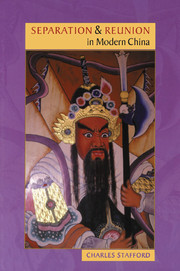Book contents
- Frontmatter
- Contents
- Acknowledgements
- Introduction: an anthropology of separation
- 1 Two festivals of reunion
- 2 The etiquette of parting and return
- 3 Greeting and sending-off the dead
- 4 The ambivalent threshold
- 5 Commensality as reunion
- 6 Women and the obligation to return
- 7 Developing a sense of history
- 8 Classical narratives of separation and reunion
- 9 The politics of separation and reunion in China and Taiwan
- Conclusion: the separation constraint
- Notes
- References
- Index
8 - Classical narratives of separation and reunion
Published online by Cambridge University Press: 22 September 2009
- Frontmatter
- Contents
- Acknowledgements
- Introduction: an anthropology of separation
- 1 Two festivals of reunion
- 2 The etiquette of parting and return
- 3 Greeting and sending-off the dead
- 4 The ambivalent threshold
- 5 Commensality as reunion
- 6 Women and the obligation to return
- 7 Developing a sense of history
- 8 Classical narratives of separation and reunion
- 9 The politics of separation and reunion in China and Taiwan
- Conclusion: the separation constraint
- Notes
- References
- Index
Summary
When seen through its distribution in time and space, the phenomenon Tu Wei-ming refers to as ‘cultural China’ seems an exceptional thing (Tu 1994). Taking Sperber's ‘epidemiological’ perspective on such matters (Sperber 1985), it is striking not only that many of the representations related to ‘cultural China’ are exceptionally widely-distributed among contemporary human populations, but also that many of these widely distributed representations have shown remarkable durability. That is, they have evolved and thus arguably ‘survived’ in some form for many centuries. Of course, this monolithic perspective on China can and probably should be brought into question; and anthropologists and historians have increasingly done so. They have stressed, for instance, the substantial historical and regional diversities of China (e.g. Faure and Siu 1995); and they have questioned essentialist definitions of ‘Chinese identity’ by drawing attention to the centrality in Chinese history of its non-Han populations (e.g. Constable 1996, Harrell 1995). This process of deconstruction is in the spirit of contemporary social science. However – and the implications of this cannot be ignored – the narrative of Chinese cultural uniformity in time and space retains a force of its own, regardless of its anthropological validity, and it has great appeal as a folk-model for many people who identify themselves as Chinese.
- Type
- Chapter
- Information
- Separation and Reunion in Modern China , pp. 144 - 155Publisher: Cambridge University PressPrint publication year: 2000



